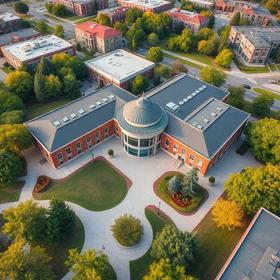Heading off to college is a time filled with excitement about the future. Meeting new people, learning new things, and experiencing college life are all events that many college students look forward to. Yet, college is also an extremely stressful time. The cost of college attendance, increased academic demands, and concerns about dating, relationships, and friendships are all common factors that contribute to an increasing number of college students that report a mental health issue.
If you find yourself feeling down, anxious, or otherwise mentally unwell, you are definitely not alone. Research from the American Psychological Association shows that 44 percent of students that seek help at their college counseling center have a severe psychological issue. That’s up from just 10 percent in 2000! Most mental health issues present themselves between the ages of 18-24 as well.
The National Alliance of Mental Illness surveyed college students diagnosed with a mental health condition within the last five years, with 19% of the surveyed individuals being community colleges. Depression and bipolar disorder constituted more than 50% of the respondents' diagnoses. The results across the spectrum were:

In this article, we review several common mental health problems that community college students face, as well as solutions to help you get back on a path to good mental health.
Depression

According to research by the National Alliance on Mental Illness (NAMI), 27 percent of college students live with some kind of depression. Depression can take many forms, from a major depressive episode to general feelings of sadness. However, regardless of the type or severity of depression, there are several common characteristics, including:
- Feelings of sadness or anxiousness
- Feelings of worthlessness, emptiness, or guilt
- Lack of interest in pleasurable activities
- Difficulty sleeping
- Fatigue
Depressive episodes are a normal part of life, such as after the death of a loved one or some other significant negative event in your life. However, depression is much more than feeling blue. It can last a long time, and if left untreated, can severely inhibit your ability to function socially, emotionally, and academically.
Bipolar Disorder

The NAMI study identifies bipolar disorder as the second most common mental health issue for college students, with 24 percent of survey respondents identifying themselves as having the disorder. Bipolar disorder involves extreme and unusual changes in one’s mood, from excessive happiness (mania) to severe depression, sometimes in the course of just a few hours. There are several types of bipolar disorder, but in general each involves the following symptoms:
- During periods of mania:
- Feelings of euphoria
- Racing thoughts and fast speech
- Distractibility and impulsivity
- Feelings of restlessness
- Little need or desire for sleep
- During periods of depression:
- Feelings of sadness or hopelessness
- Loss of interest in pleasurable activities
- Difficulty concentrating and remembering
- Indecisiveness
- Changes in eating and sleeping habits
- Thoughts of death or suicide
College students with bipolar disorder may have extreme difficulty maintaining friendships and staying on top of their studies. Bipolar disorder can occur in minor forms, in which you just feel really good sometimes and not so good other times. However, left untreated it can turn into a severe illness that makes it nearly impossible to have success in school.
Anxiety

Going to college is a time wrought with the potential for anxiety. Perhaps you’re leaving home for the first time or are worried about your ability to make new friends. Your class load is certainly a source of stress, from the number of classes you have to the time required to get all your studying and homework done. Being anxious in these situations is totally normal, but when anxiousness becomes a constant in your life, there may be a deeper issue at hand.
Anxiety disorders take many, many different forms. Obsessive-compulsive disorder, phobias, social anxiety disorder, post-traumatic stress disorder, and panic disorder are just a few types of anxiety identified by mental health professionals. Regardless of the specific type, anxiety disorders share some common features:
- Excessive feelings of anxiety or worry
- Restlessness or feelings of being “on edge”
- Difficulty sleeping
- Significant impairment in daily functioning
The type of anxiety disorder will determine the specific symptoms. For example, students with obsessive-compulsive disorder suffer from uncontrollable thoughts and engage in repetitive behaviors. Students with a social phobia will exhibit panic when confronted with a social situation. Students with panic disorder constantly worry about having a panic attack. Like depression and bipolar disorder, if these symptoms aren’t treated, anxiety can consume your life.
Mental Health Services Grow at Community Colleges
As the number of students enrolled in community college grew rapidly in the 2000s, counseling centers at those institutions had difficulty keeping pace with demand for services. According to research by the American College Counseling Association (ACCA), just 73 percent of community colleges provide mental health counseling services on campus. While not on par with the number of universities that offer such services, this does represent slow yet steady growth in the availability of mental health programs. The number of community colleges with on-campus services has increased, as has the number of institutions with a behavioral intervention team. The number of schools that provide access to a mental health professional for referral services has nearly doubled, while the number of counseling centers with multiple counselors has increased. What’s more, a significant number of the community colleges that do not offer on-campus services report contracting with an off-campus provider to meet the mental health needs of their students.
Types of Services

Community college counseling centers generally offer a wide variety of services to assist students who are in the midst of a mental health issue. Currently, there is a specific focus on preventative programs and intervention measures to address the mental health needs of students before they become a major mental health concern. The California Community College Student Mental Health Program (CCC SMHP) is one of the largest of its kind in the nation. CCC SMHP offers training programs to community college staff members to better equip them to recognize the signs and symptoms of common mental health issues. Intervention programs, such as suicide hotlines, are also a central feature of CCC SMHP and are offered on many community college campuses throughout the nation as well.
Many community colleges offer outreach and educational programming. At Owens Community College in Ohio, staffers from the Student Mental Health Services office provide workshops and seminars to groups of students in various campus environments. Common topics include depression, anxiety, and stress management techniques. Participants in these workshops learn about common symptoms, healthy ways to overcome mental health difficulties, and get information about where to seek help.
Community college counseling centers often provide group counseling as well. At Connecticut College, group counseling involves between five and eight students who work together with a counselor to address areas of need, receive feedback and encouragement from others, and learn skills that will help them achieve their mental health goals. At San Diego City College, groups take on a slightly different look, primarily offering opportunities for skill-building and informal learning. Rather than focusing on small groups for mentally ill students, groups at the college focus on issues like stress-reduction and improving relationships for larger groups of students.
Short-term individual counseling, such as that provided at Red Rocks Community College, offers students an opportunity to work with a counselor on a one-on-one basis. Counselors in their Behavioral Health Services Department help students identify the primary problem they are facing, help them work through their feelings, and identify potential solutions to current life problems. Counselors will often assign “homework” for students to work on between sessions, and provide feedback about their progress toward better mental health. If, after several sessions, students don’t feel like they are making progress, or the counselor isn’t satisfied with their progress together, students might be referred to additional services provided by an off-campus mental health counselor.
Conclusion
Mental health issues are extremely common. And while services at community colleges aren’t yet ideal, they are vastly improved from where they were even just five or ten years ago. If you find yourself struggling with a personal, social, emotional, or mental health issue, seek assistance at your on-campus counseling center. If your school doesn’t have onsite services, ask your advisor or a trusted professor for information about where you can find help. Mental health issues do not have to derail your dreams of a college degree, nor do they have to prevent you from achieving your personal and social goals. Seeking help is easier now than ever before. It’s just a matter of taking that first step and asking someone for help.












